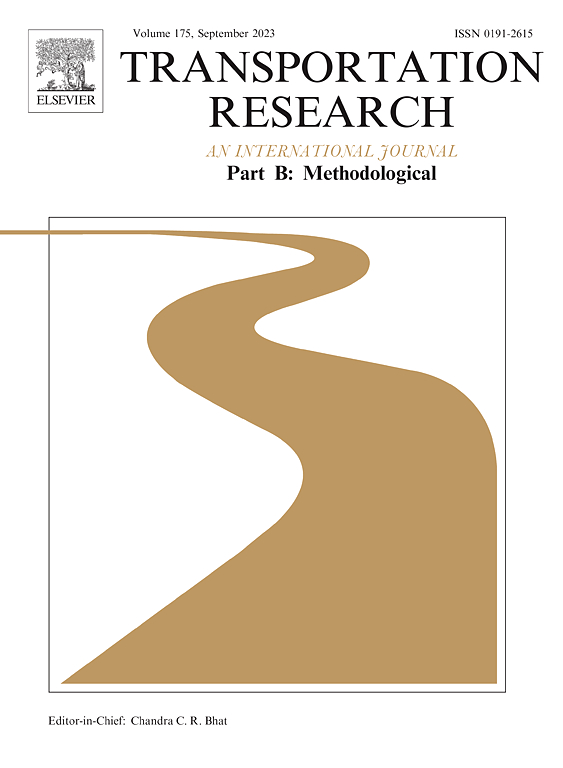Robust control for connected automated vehicle platoon with multiple-predecessor following topology considering communication loss
IF 6.3
1区 工程技术
Q1 ECONOMICS
引用次数: 0
Abstract
The paper presents a robust control method for effectively managing uncertainties and communication loss in a connected automated vehicle (CAV) platoon under the multiple-predecessor following (MPF) topology. The proposed approach incorporates uncertainties in vehicle dynamics, such as vehicle parameters and environmental resistances, into the closed-loop platoon system to enhance the robustness of the platoon controller. The impacts of communication loss are analyzed specifically for the MPF topology, considering potential disruptions in information flow among different numbers and locations of predecessors in a CAV platoon. A novel formulation of desired spacing, suitable for CAV platoon with the MPF topology under communication loss, is then developed based on the constant time headway (CTH) policy. Furthermore, the paper derives and proves the sufficient and necessary conditions for the local stability of the proposed robust platoon controller using Kharitonov's theorem. The sufficient conditions for string stability are also discussed through frequency-domain analysis and combined with the Lyapunov function to determine the relationship between average dwell time and maximum allowable delay, ensuring platoon string stability under switching communication topology. These conditions establish the stability region for the robust controller of a CAV platoon with varying locations and numbers of unconnected predecessors. Simulation experiments are conducted to demonstrate that the stability region of the controller diminishes as the number of unconnected predecessors increases, with the greatest impact observed when the communication with the nearest connected predecessor is lost. Additionally, the control performance is affected by uncertain dynamics and the range of time headway, resulting in a significant reduction in the stability region. The findings highlight the importance of fine-tuning control parameters within the stability region guided by the derived stability conditions to ensure both local and string stability of CAV platoons.
考虑通信损失的多前驱跟踪拓扑互联自动车辆排鲁棒控制
提出了一种鲁棒控制方法,在多前导跟随(MPF)拓扑下有效地管理互联自动车辆(CAV)队列中的不确定性和通信损失。该方法将车辆动力学中的不确定性因素(如车辆参数和环境阻力)引入到闭环排控系统中,增强了排控控制器的鲁棒性。考虑到CAV排中不同数量和位置的前导部队之间信息流的潜在中断,本文专门分析了通信丢失对MPF拓扑结构的影响。基于恒时距(CTH)策略,提出了一种适用于通信丢失情况下具有MPF拓扑的CAV排的新期望间距公式。利用Kharitonov定理,推导并证明了所提鲁棒排控制器局部稳定的充要条件。通过频域分析,结合Lyapunov函数,讨论了排串稳定的充分条件,确定了平均停留时间与最大允许时延之间的关系,保证了排串在交换通信拓扑下的稳定性。这些条件建立了具有可变位置和未连接前驱数量的CAV排鲁棒控制器的稳定区域。仿真实验表明,控制器的稳定区域随着未连接的前代数量的增加而减小,当与最近连接的前代失去通信时影响最大。此外,控制性能受到不确定动力学和车头时距范围的影响,导致稳定区域显著减小。研究结果强调了在导出的稳定条件的指导下,在稳定区域内微调控制参数以确保CAV排的局部和串稳定的重要性。
本文章由计算机程序翻译,如有差异,请以英文原文为准。
求助全文
约1分钟内获得全文
求助全文
来源期刊
CiteScore
12.40
自引率
8.80%
发文量
143
审稿时长
14.1 weeks
期刊介绍:
Transportation Research: Part B publishes papers on all methodological aspects of the subject, particularly those that require mathematical analysis. The general theme of the journal is the development and solution of problems that are adequately motivated to deal with important aspects of the design and/or analysis of transportation systems. Areas covered include: traffic flow; design and analysis of transportation networks; control and scheduling; optimization; queuing theory; logistics; supply chains; development and application of statistical, econometric and mathematical models to address transportation problems; cost models; pricing and/or investment; traveler or shipper behavior; cost-benefit methodologies.

 求助内容:
求助内容: 应助结果提醒方式:
应助结果提醒方式:


